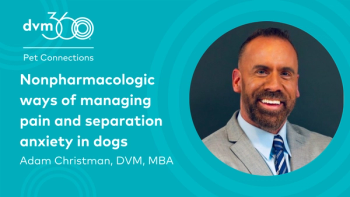
Economically some practices in 'Wonderland'
The time has come the Walrus said to speak of many things. Of shoes and ships and sealing wax and other inconsequential things.
The time has come the Walrus said to speak of many things. Of shoes and ships and sealing wax and other inconsequential things.
Of clients and patients and staff and clients that are tough.
And money and bottom lines and other boring economic stuff.
I really should write a book and title it "Veterinarians in Wonderland".
It would be fiction of course because a true documentary about the economicsof practice today would read more like a tragedy and would make the NewYork Times worst seller list.
The bane (that means the bad stuff) of veterinary medicine today is staffing.Hospitals with well-trained, well-compensated staff, who can be expectedto remain in their positions long enough to justify the expense of training,are very few and far between.
Eighty percent of American veterinary hospitals are understaffed today.Oh! They may have the recommended minimum of three full-time equivalentsper veterinarian, but that's only quantity. These may be fine upstandingmembers of the community, but their poor training in client education andjob knowledge is only exceeded by their lack of product knowledge.
I know of a dozen hospitals within driving distance of technician programsthat have paid for their staff to attend these institutions.
When they graduated, they were able to boost their earnings by a magnificentdollar an hour. Of course, these staff, their education paid by the hospital,just up and left at the earliest opportunity to find that extra half dollaran hour elsewhere (i.e. down the road).
How much easier and cost effective it would have been to spend $1,800or so on a complete training program on DVD or VHS and let them spend anhour or two a week honing their skills. (Animal Care Training 800-357-3182or AVLS 800-444-3634) The DVDs stay with the hospital forever and can trainthe next 4,000 new hires before they wear out. Of course, it has not beenunheard of to require staff members who have been with you a dozen or moreyears, and know it all, to learn even more about that which they thoughtthey knew it all.
Read the next part very carefully!
In the next five years, many practices are going to be closed.
There are two reasons. The most common will be those veterinarians whohave been mismanaging their practices for decades and their net income neverexceeded 25 percent of their gross. They will not be able to find a buyerwilling to put out good money to earn less than they would as an associatesomewhere else. They should be netting at least 35 percent. A 10 percentloss on $400,000 gross, in 30 years of dedicated toil, means a loss to thebottom line and the retirement account of a quarter million dollars. Andif they were lucky enough to find a sucker buyer, they would get less thanhalf of their last year's gross revenues for the practice. Of course, thereal estate and equipment have value, that is true, unless the neighborhoodhas deteriorated.
The other set of practice closures will be those, young or old, who locatedin an area that never could or can no longer support their or any otherpractice.
They had good reasons, all economically unsound. "I grew up in thisneighborhood." "They need a veterinarian here, no one else willcome in." There are three other hospitals here, it must be a good area.""The fishing and hunting are great." "It's so close to theocean."
Supermarket and drug store chains would never do that. They spend thousandson research on predicted growth rate, traffic patterns, now and into thenext decade. Average household income. Ethnic dietary preferences. Eventhen, when they find that the neighborhood changes or the factory supportingall the residences fails, they relocate fast!
Location, location, location
Hospitals in the wrong location may not have fared too poorly in the90's, but now, in the third year of a recession, the burden is just toomuch for too many, and there are no buyers to repeat their error of location.They might have saved a lot of grief if they had recognized their errorslong ago and skedaddled. Too late for that now!
Both of these syndromes add up to one thing.
Veterinarians should be canonized as saints. There should be long linesof grateful clients, made aware of how their "Doc" did withoutto subsidize their patient's healthcare with their own money. These clientsshould all whip out their checkbooks and make a check payable to your retirementfund.
Otherwise, there is only one conclusion. Sit down with your client andsee what your percentage net is "as a veterinarian." Not as areal estate holder.
Ask yourself, practice owners, "After paying fair rent for a propertyof this value, am I getting to take home (before taxes) 25 percent of mypersonal production? Solo practitioners can use 20 percent of the grosshere. This is for medical performance only. Add another 15 percent of thegross for management. That's a total of 35 percent of gross. Now, the bigquestion: What about profit to the stockholders.
If there is nothing left after paying yourself 35 percent, you have ajob, not a business. A business makes a profit after paying their staff.Businesses on the stock exchange not averaging 10 percent profit do notremain long in business.
If you are lucky enough to find your net between 35 and 40 percent, youhave the funds to upgrade your staff's veterinary I.Q., to help you staythat way. Train, train and train more.
Anyone who thinks he or she could fashion a Stradivarius with a hatchetis headed for much worse times. This recession is far from over.
Are you prepared to retire and live on Social Security and rent fromthe building that used to be a veterinary facility? Will you be on a streetcorner waving a sign "Will spay for food?" Or, are you going tosit down right now and look at your books to see that you really net over35 percent? Ostriches do not really bury their heads in the sand, but someveterinarians do. Think! n
Newsletter
From exam room tips to practice management insights, get trusted veterinary news delivered straight to your inbox—subscribe to dvm360.




